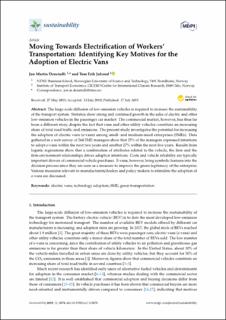Moving Towards Electrification of Workers’ Transportation: Identifying Key Motives for the Adoption of Electric Vans
Journal article
Published version
Permanent lenke
https://hdl.handle.net/11250/2759270Utgivelsesdato
2019Metadata
Vis full innførselSamlinger
- Journal articles [478]
Originalversjon
10.3390/su11143878Sammendrag
The large-scale diffusion of low-emission vehicles is required to increase the sustainability
of the transport system. Statistics show strong and continued growth in the sales of electric and other
low-emission vehicles in the passenger car market. The commercial market, however, has thus far
been a different story, despite the fact that vans and other utility vehicles constitute an increasing
share of total road traffic and emissions. The present study investigates the potential for increasing
the adoption of electric vans (e-vans) among small- and medium-sized enterprises (SMEs). Data
gathered in a web survey of 264 SME managers show that 25% of the managers expressed intentions
to adopt e-vans within the next two years and another 27% within the next five years. Results from
logistic regressions show that a combination of attributes related to the vehicle, the firm and the
firm-environment relationships drives adoption intentions. Costs and vehicle reliability are typically
important drivers of commercial vehicle purchases. E-vans, however, bring symbolic features into the
decision process since they are seen as a measure to improve the green legitimacy of the enterprise.
Various measures relevant to manufacturers/dealers and policy makers to stimulate the adoption of
e-vans are discussed.
